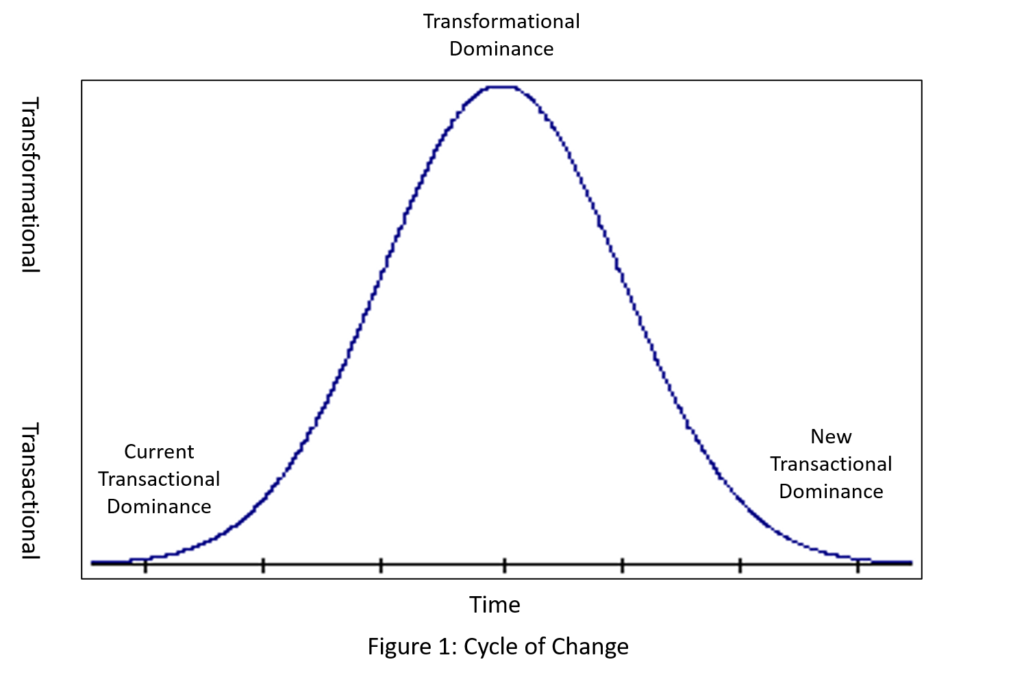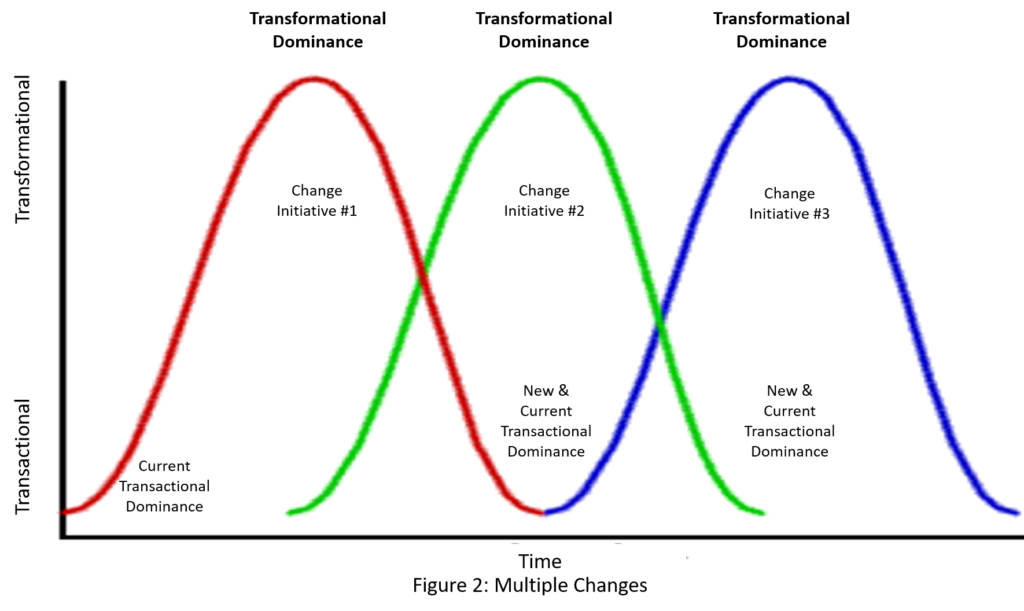New perspectives on transactional vs. transformational leadership

The conflict between the narrow focus on operational excellence often required to keep your current business running well versus broad demands for organizational transformation required for the future business has become severe. Leaders have to simultaneously minimize disruption to their current business while consciously disrupting it to make the changes required for rapidly evolving markets.
Several years ago, I wrote an article titled “Transformational Leadership in a Transactional World” which explored the conflict between transactional and transformational leadership and proposed some ways to become more transformational while still maintaining operational excellence. In the intervening years, the emergence of mindfulness and research on the neuroscience of learning suggest new approaches for providing transformational leadership while keeping the existing business running smoothly.
What is the conflict between transactional excellence and transformation? Maintaining today’s revenues usually depends on the operational efficiency created by standardizing work flows and processes – i.e. converting everything into a defined transaction — to achieve well-defined transactional performance metrics. Variation is minimalized and disruption is seen as failure. Conversely, transformational change is the deliberate introduction of disruption to existing business processes to prepare for an often unknown future. Flexibility, innovation and risk-taking, none of which are easily measured, are essential to transformational success. The contradiction is obvious. Transactional leadership wants to reduce variance while transformational leadership wants to drive change by increasing variance.
To get a little more sophisticated, a typical change curve looks like Figure 1. The curve begins with leadership focusing on operational excellence for the current business (the left side of the curve). This gradually shifts as change gets introduced, with less emphasis on transactional excellence and more emphasis on the transformation, until, at the apex of the curve, transformational leadership dominates. As the curve slopes to the right, operational excellence is reestablished, but in the new paradigm and transactional leadership is more important. So, at times, a leader must be primarily a transactional leader, at other times primarily a transformational leader, and must be able to shift smoothly between these modes at the best time.

To make things more complicated, since change is constant now, multiple change curves can overlap as shown in Figure 2. A leader might therefore be shifting from transformational back to transactional for one initiative only to have to shift into transformational mode for a new initiative. Leaders have a hard time knowing when to be transactional and when to be transformational.

So, what can you do about this conflict? The first thing to do is recognize that transformational leadership is very different from transactional leadership. Most leaders are well-schooled in transactional leadership because organizations have historically focused so intensely on creating efficiencies and because transformations used to be relatively rare. Consequently, few leaders realize that transformational leadership attitudes and skills are completely different from transactional leadership and therefore tend to try to lead change in the same way they lead standard operational situations. So, begin by asking yourself: “How am I going to lead differently in order to lead a transformation?” Great transformations always begin with the transformation of the leaders.
Second, be mindful of when and how these conflicting pressures become most acute (the curves) and be aware of the issues – personal and organizational — they create. This recognition now goes under the general concept of “mindfulness.” Mindfulness is the conscious practice of using the intellect to monitor and manage emotional responses. As you progress through the curves, be consciously aware of where you are on the curve by asking yourself the question, “What is the mix of transactional and transformational attitudes and skills required for my specific situation?” Just taking a few moments to ask yourself this question – and answer it – makes a huge difference in your ability to simultaneously be a great transactional leader and a driver of significant change.
Third, make a commitment to learning the new approaches to transformational leadership that are emerging from neuroscience research on brain function during change. While neuroscience research is an extraordinarily rich field right now, there are three primary concepts that can help you become a transformational leader right now:
-
- Focus on moving toward a compelling purpose for the change for yourself and for your team. A compelling purpose is the social good – for the customer, organization, and/or society — that will come from the change. Neuroscience research shows that when people are positively and proactively working toward a compelling purpose, they release neurochemicals that increase both openness to new ideas and speed of adoption of the new ideas. This is in sharp contrast to a focus on assessing the current state which the research shows generates the neurochemicals associated with resistance to change. Move toward something important, not away from something that is inadequate.
-
- Consciously manage the two-week period 6-8 weeks into a transformation that is the time of maximum resistance to change. Research shows that the brain defends the old, more efficient operational processes most intensely at 6-8 weeks into a change. This means that you can expect the greatest resistance to a change to occur just at the time you are transitioning to being more transformational. The best way to get through this period is to use mindfulness to recognize – and guide your team to recognize – that the discomfort everyone is feeling is the brain (and the organization) giving up the older more comfortable processes (personal and business) in order to achieve the compelling purpose. Just keep working at the change and the resistance tends to disappear at about the eighth week.
-
- Give the time and support needed for both you and your team to master the new efficiencies and permission to be not very good at them for quite a while. This is really hard for people striving to reduce variance by standardization – you must introduce and support less standardization and higher levels of variance during the transformation process. Neuroscience shows that it is the practice of the new capabilities that ultimately moves you down the right side of the curve to become a great transactional leader again.
Here is an interesting data point. Leaders who spend more time in transformational mode than in transactional mode consistently outperform more purely transaction leaders on transactional metrics. That’s right. You do better as a transactional leader if you are primarily and consistently a transformational leader. The goal is to consciously work to become a transformational leader.

